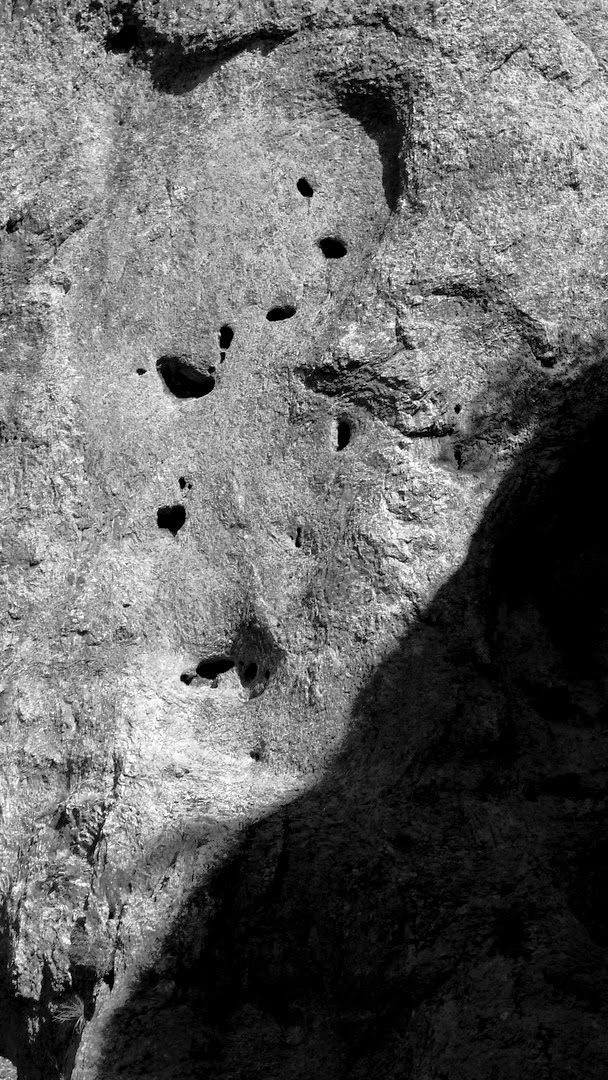Arriving at twilight, my timing was perfect to begin the day without the use of a headlamp. Life in winter is generally a drag to me in the southwest. Fewer daylight hours, morning runs spent with additional mounting minutes of darkness each day, and little snow tend to get me a little down for a couple of months. What I'm discovering in my 2nd winter in Silver City however is that at the very least the quality of light is consistently excellent. The low southern sun and general clarity of sky makes getting up in the mountains more enjoyable to photograph. Add in wispy clouds, and there seems to be more to look at than in the peak of summer. Yin and yang and increased appreciation.

The hiking up to Windy Gap was fun with frequent hops across Little Dry Creek. The trail frequently clung steeply to the hillsides to climb behind cliffs that pinch the canyon tight. About a year ago I did this exact same hike, but the terrain above Windy Gap would be terra incognita.
Part of the beauty of spending time in the Gila Wilderness is that there is essentially zero up to date trail information online. Hell, there really aren't very many trip reports from the past decade at all, aside from the common trips up the forks of the Gila River and Whitewater Creek. Picking a trail like upper Little Dry Creek and looking at burn intensity maps from the Whitewater-Baldy Fire nearly ensures a little bit of doubt and adventure. This is exactly what I sought and found in spades. The trails were good enough, though would likely be deemed "poor" by anyone used to trails in more frequently used areas. Plenty of burnt trees presented themselves, but I was surprised to see some in tact evergreens and aspens as well. Nearing the ridge that led to West Baldy, I spooked a few massive bull elk that charged downhill, through catclaw, tangle, and all.
Although the route out to West Baldy is half of a mile without an official trail, I was happy to find pieces of a game trail to follow. This trail petered out in places, especially when intensely thick stands of catclaw were encountered.
Wind was beginning to pick up and I made the mistake of trying to hike the ridge wearing my beloved Patagonia Houdini wind jacket. Pretty quickly thorns started to poke into the jacket and potentially shred my Ultimate Direction SJ running vest. Every time I get out into the wilderness I think that I may need burlier fabrics, and the thorns encountered on this trip reinforced that opinion. A custom dyneema Sub-60 pack design may find it's way under the sewing machine in the near future as a result. All of the catclaw cursing was worth it, and the view from West Baldy is probably the best I've seen in the Gila yet. A fully bald summit, talus and all, at the end of a ridge with massive views into AZ to the west, Big Dry Canyon and the ridges of the Wilderness to the North, and Cooke's Peak peeking through to the East. Learning the lay of the land from this vantage is part of the reason for getting out. Finally seeing Rain Creek Mesa, Sacaton Creek, Sacaton Mtn, Big Dry, and the San Francisco River in the flesh instead of as topo lines was rewarding. The views of King and Queens Crown inspired the desire to create a route up Dog Canyon and follow the ridge to the top. Next time, always next time.
How many people make it up here? So so worth it.
After sitting and gawking for 30 minutes I began the dreaded trip back along the ridge. Slightly more intelligent from experience, I decided to drop low off the ridge and contour along the slope to avoid the worst of the catclaw. It wasn't that much easier though due to the steep nature of the terrain and numerous blowdowns underfoot. At least I learned something on this trip, and that along with the big views made this all worthwhile.








































































